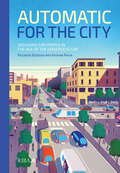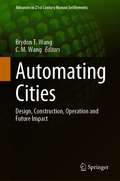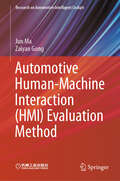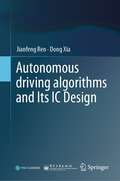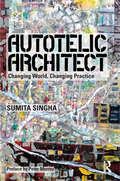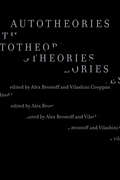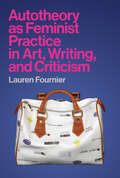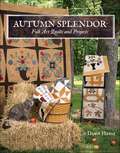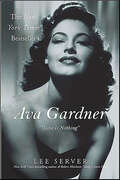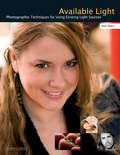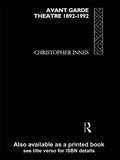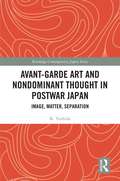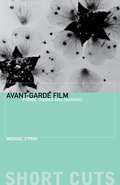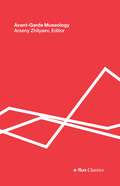- Table View
- List View
Automatic Calibration and Reconstruction for Active Vision Systems (Intelligent Systems, Control and Automation: Science and Engineering #57)
by Y. F. Li Beiwei ZhangIn this book, the design of two new planar patterns for camera calibration of intrinsic parameters is addressed and a line-based method for distortion correction is suggested. The dynamic calibration of structured light systems, which consist of a camera and a projector is also treated. Also, the 3D Euclidean reconstruction by using the image-to-world transformation is investigated. Lastly, linear calibration algorithms for the catadioptric camera are considered, and the homographic matrix and fundamental matrix are extensively studied. In these methods, analytic solutions are provided for the computational efficiency and redundancy in the data can be easily incorporated to improve reliability of the estimations. This volume will therefore prove valuable and practical tool for researchers and practioners working in image processing and computer vision and related subjects.
Automatic Digital Document Processing and Management: Problems, Algorithms and Techniques (Advances in Computer Vision and Pattern Recognition)
by Stefano FerilliThis text reviews the issues involved in handling and processing digital documents. Examining the full range of a document's lifetime, the book covers acquisition, representation, security, pre-processing, layout analysis, understanding, analysis of single components, information extraction, filing, indexing and retrieval. Features: provides a list of acronyms and a glossary of technical terms; contains appendices covering key concepts in machine learning, and providing a case study on building an intelligent system for digital document and library management; discusses issues of security, and legal aspects of digital documents; examines core issues of document image analysis, and image processing techniques of particular relevance to digitized documents; reviews the resources available for natural language processing, in addition to techniques of linguistic analysis for content handling; investigates methods for extracting and retrieving data/information from a document.
Automatic for the City: Designing for People In the Age of The Driverless Car
by Riccardo Bobisse Andrea Andrea PaviaHow will automated vehicles change our lives? Where are the opportunities and challenges? Future streets require planning today. This timely book envisions ways in which changes to urban mobility and technology will transform city streetscapes and, importantly, how cities can prepare. It is a reflection on the relationship between new technologies and urbanism, as well as an agile urban design manual with pictures illustrating potential spatial arrangements enabled by the new technologies. Two case studies in the central urban cores of London and Los Angeles will be presented to show how neighborhoods can be redesigned for the better and how to apply good urban design principles across towns and cities worldwide.
Automating Cities: Design, Construction, Operation and Future Impact (Advances in 21st Century Human Settlements)
by C. M. Wang Brydon T. WangThis book highlights the latest advancements in the use of automated systems in the design, construction, operation and future of the built environment and its occupants. It considers how the use of automated decision-making frameworks, artificial intelligence and other technologies of automation are presently impacting the practice of architects, engineers, project managers and contractors, and articulates the near future changes to workflows, legal frameworks and the wider AEC industry. This book surveys and compiles the use of city apps, robots that operate buildings and fabricate structural elements, 3D printing, drones, sensors, algorithms, and advanced prefabricated modules. The book also contributes to the growing literature on smart cities, and explores the impacts on data privacy and data sovereignty that arise through the use of sensors, digital twins and intelligent transport systems. It provides a useful reference for further research and development in the area of automation in design and construction to architects, engineers, project managers, superintendents and construction lawyers, contractors, policy makers, and students.
Automotive Human-Machine Interaction (Research on Automotive Intelligent Cockpit)
by Jun Ma Zaiyan GongThis book focuses on the evaluation methodology for automotive human-machine interaction (HMI), which aim to reduce driving distractions, lower operational loads, optimize user experience design, and enhance user value.The book is divided into three parts. The first part, consisting of Chapters 1–3, introduces the evolution of automotive HMI and proposes a three-dimensional orthogonal evaluation system for automotive HMI that is comprehensive, systematic, and quantifiable. This evaluation system incorporates all evaluation items into a spatial matrix consisting of three dimensions: interaction tasks, interaction modalities, and evaluation indexes. The second part provides a comprehensive presentation and in-depth discussion of the evaluation indexes. The three rational evaluation indexes are utility, safety, and efficiency, which can be tested by the real-car driving simulator. The four emotional evaluation indexes are cognition, intelligence, value, and aesthetics. In orderto standardize the latter two subjective indexes, this book summarizes common differences in value between Chinese and European users and organizes typical aesthetic orientations in automotive UI based on art history research. The third part introduces the application of this HMI evaluation system in the automotive R&D process, including how to integrate the evaluation into a real product development process to achieve efficient product iteration.This book is suitable for intelligent cockpit and HMI designers, engineers, and researchers. It is also used as a reference for product managers and students in the field of intelligent connected vehicles.
Automotive Painting Technology: A Monozukuri-Hitozukuri Perspective
by Kozo Saito Abraham Salazar Kimio TodaThis book offers unique and valuable contributions to the field. It offers breadth and inclusiveness. Most existing works on automotive painting cover only a single aspect of this complex topic, such as the chemistry of paint or paint booth technology. Monozukuri and Hitozukuri are Japanese terms that can be translated as "making things" and "developing people" but their implications in Japanese are richer and more complex than this minimal translation would indicate. The Monozukuri-Hitozukuri perspective is drawn from essential principles on which the Toyota approach to problem-solving and continuous improvement is based. From this perspective, neither painting technology R&D nor painting technology use in manufacturing can be done successfully without integrating technological and human concerns involved with making and learning in the broadest sense, as the hyphen is meant to indicate. The editors provide case studies and examples -- drawn from Mr. Toda's 33 years of experience with automotive painting at Toyota and from Dr. Saito's 18 years experience with IR4TD, the research-for-development group he leads at the University of Kentucky -- that give details on how these two principles can be integrated for successful problem-solving and innovation in industry, in university R&D, and in the collaboration between the two. The book will bring readers up to date on progress in the field over the last decade to provide a basis for and to indicate fruitful directions in future R&D and technology innovation for automotive painting.
Automotive Prosthetic: Technological Mediation and the Car in Conceptual Art
by Charissa N. TerranovaIn the twenty-first century, we are continually confronted with the existential side of technology—the relationships between identity and the mechanizations that have become extensions of the self. Focusing on one of humanity’s most ubiquitous machines, Automotive Prosthetic: Technological Mediation and the Car in Conceptual Art combines critical theory and new media theory to form the first philosophical analysis of the car within works of conceptual art. These works are broadly defined to encompass a wide range of creative expressions, particularly in car-based conceptual art by both older, established artists and younger, emerging artists, including Ed Ruscha, Martha Rosler, Richard Prince, Sylvie Fleury, Yael Bartana, Jeremy Deller, and Jonathan Schipper. At its core, the book offers an alternative formation of conceptual art understood according to technology, the body moving through space, and what art historian, curator, and artist Jack Burnham calls “relations. ” This thought-provoking study illuminates the ways in which the automobile becomes a naturalized extension of the human body, incarnating new forms of “car art” and spurring a technological reframing of conceptual art. Steeped in a sophisticated take on the image and semiotics of the car, the chapters probe the politics of materialism as well as high/low debates about taste, culture, and art. The result is a highly innovative approach to contemporary intersections of art and technology.
Autonomie der Kunst?: Zur Aktualität eines gesellschaftlichen Leitbildes (Kunst und Gesellschaft)
by Uta Karstein Nina Tessa ZahnerDer Band diskutiert in interdisziplinärer Breite die Frage, inwiefern Kunst autonom oder von ihren jeweiligen Kontexten abhängig ist.
Autonomous Driving Perception: Fundamentals and Applications (Advances in Computer Vision and Pattern Recognition)
by Rui Fan Sicen Guo Mohammud Junaid BocusDiscover the captivating world of computer vision and deep learning for autonomous driving with our comprehensive and in-depth guide. Immerse yourself in an in-depth exploration of cutting-edge topics, carefully crafted to engage tertiary students and ignite the curiosity of researchers and professionals in the field. From fundamental principles to practical applications, this comprehensive guide offers a gentle introduction, expert evaluations of state-of-the-art methods, and inspiring research directions. With a broad range of topics covered, it is also an invaluable resource for university programs offering computer vision and deep learning courses. This book provides clear and simplified algorithm descriptions, making it easy for beginners to understand the complex concepts. We also include carefully selected problems and examples to help reinforce your learning. Don't miss out on this essential guide to computer vision and deep learning for autonomous driving.
Autonomous Intelligent Vehicles: Theory, Algorithms, and Implementation (Advances in Computer Vision and Pattern Recognition)
by Hong ChengThis important text/reference presents state-of-the-art research on intelligent vehicles, covering not only topics of object/obstacle detection and recognition, but also aspects of vehicle motion control. With an emphasis on both high-level concepts, and practical detail, the text links theory, algorithms, and issues of hardware and software implementation in intelligent vehicle research. Topics and features: presents a thorough introduction to the development and latest progress in intelligent vehicle research, and proposes a basic framework; provides detection and tracking algorithms for structured and unstructured roads, as well as on-road vehicle detection and tracking algorithms using boosted Gabor features; discusses an approach for multiple sensor-based multiple-object tracking, in addition to an integrated DGPS/IMU positioning approach; examines a vehicle navigation approach using global views; introduces algorithms for lateral and longitudinal vehicle motion control.
Autonomous Vehicles and Virtual Reality: The New Automobile Industrial Revolution
by Andras KemenyThis book concisely describes the technologies, human perception, and cognition issues relevant to autonomous vehicles. It also gives an insight in the changes bring about our future everyday lives.Autonomous vehicles are the future of the automobile industry. Automated driving (AD), also called self-driving, raises however several multiple questions, among them those of user safety and acceptation. Comprehensive HMI system design, with windshield display technics, will be necessary to deal with driving task delegations, bringing the use of VR or augmented reality (AR) technologies. In addition, the use of VR for all the vehicle interiors will progressively be proposed for entertainment, online business activities and for modified visual motion perception to alleviate car sickness, a form of motion sickness. Indeed, car sickness is already well known for many passengers, especially when reading or operating smartphones or other display devices. It is called to increase significantly with the introduction of autonomous vehicles where all users will be for long periods in various sitting positions. These two new trends, AD and VR, are already modifying our relationship with the world and the society. All together, they will change our way of life forever. The book will be of interest to professionals in the auto industry, researchers in automotive engineering and computer science and all those interested in the future of transport.
Autonomous driving algorithms and Its IC Design
by Jianfeng Ren Dong XiaWith the rapid development of artificial intelligence and the emergence of various new sensors, autonomous driving has grown in popularity in recent years. The implementation of autonomous driving requires new sources of sensory data, such as cameras, radars, and lidars, and the algorithm processing requires a high degree of parallel computing. In this regard, traditional CPUs have insufficient computing power, while DSPs are good at image processing but lack sufficient performance for deep learning. Although GPUs are good at training, they are too “power-hungry,” which can affect vehicle performance. Therefore, this book looks to the future, arguing that custom ASICs are bound to become mainstream. With the goal of ICs design for autonomous driving, this book discusses the theory and engineering practice of designing future-oriented autonomous driving SoC chips.The content is divided into thirteen chapters, the first chapter mainly introduces readers to the current challenges and research directions in autonomous driving. Chapters 2–6 focus on algorithm design for perception and planning control. Chapters 7–10 address the optimization of deep learning models and the design of deep learning chips, while Chapters 11-12 cover automatic driving software architecture design. Chapter 13 discusses the 5G application on autonomous drving. This book is suitable for all undergraduates, graduate students, and engineering technicians who are interested in autonomous driving.
Autonomy: The Social Ontology of Art under Capitalism
by Nicholas BrownIn Autonomy Nicholas Brown theorizes the historical and theoretical argument for art's autonomy from its acknowledged character as a commodity. Refusing the position that the distinction between art and the commodity has collapsed, Brown demonstrates how art can, in confronting its material determinations, suspend the logic of capital by demanding interpretive attention. He applies his readings of Marx, Hegel, Adorno, and Jameson to a range of literature, photography, music, television, and sculpture, from Cindy Sherman's photography and the novels of Ben Lerner and Jennifer Egan to The Wire and the music of the White Stripes. He demonstrates that through their attention and commitment to form, such artists turn aside the determination posed by the demand of the market, thereby defeating the foreclosure of meaning entailed in commodification. In so doing, he offers a new theory of art that prompts a rethinking of the relationship between art, critical theory, and capitalism.
Autotelic Architect: Changing world, changing practice
by Sumita SinghaAutotelic Architect explores how movements towards more self-initiated projects, greater collaboration and design activism have changed how architects and designers are practicing, as well as the kinds of projects they are working on. Similar to the autotelic self that transforms potential problems into enjoyable challenges, the ‘Autotelic Architect’ does not avoid societal changes, but instead learns to harness their creative potential. Using new research and case studies from past and present, the author analyses the educational and professional implications of operating as a ‘non-conventional’ progressive participatory design practice. Drawing on a range of global case studies of pioneering architects in the field, she reflects upon current and future trends at local, national and international level, and additionally examines marketing and practical issues for architects. Illustrated with more than 30 black and white images, this is a compelling read for any practicing architect.
Autotheories
by Alex Brostoff and Vilashini CooppanA transdisciplinary array of authors offering a new frame of reference for autotheory and its genre-bending synthesis of autobiography and critical theory.Autotheories tells the story of a field in formation. Building on traditions that have long fused life writing, philosophical encounter, embodied theorizing, and cultural critique, autotheory constructs new practices of critical theory. Transgressing generic boundaries and bridging stylistic registers, it crafts language that is intimate, analytic, playful, and insurgent. Editors Alex Brostoff and Vilashini Cooppan underscore autotheory&’s multiple genealogies and genre-bending forms while situating it within the contemporary political field. In this collection, autotheory emerges as a strut (of style), a straddle (of disciplines), a proliferation (of selves), an axis (of identifications), an index (of attachments), and an archive (of loves). An assemblage and an experience, Autotheories surveys the field&’s iterations and permutations. Without settling for classification or bowing to ossification, Autotheories invites you to its discursive play.Contributors include:Alex Brostoff, Jessica Bush, Judith Butler, Vilashini Cooppan, Carla Freccero, rl Goldberg, Jan Grue, Emma Lieber, Megan Moodie, Lili Owen Rowlands, John Patterson, Paul B. Preciado, Erica Richardson, Migueltzinta C. Solís, Jamieson Webster, Damon Ross Young, Stacey Young, Arianne Zwartjes
Autotheory as Feminist Practice in Art, Writing, and Criticism
by Lauren FournierAutotheory--the commingling of theory and philosophy with autobiography--as a mode of critical artistic practice indebted to feminist writing and activism.In the 2010s, the term "autotheory" began to trend in literary spheres, where it was used to describe books in which memoir and autobiography fused with theory and philosophy. In this book, Lauren Fournier extends the meaning of the term, applying it to other disciplines and practices. Fournier provides a long-awaited account of autotheory, situating it as a mode of contemporary, post-1960s artistic practice that is indebted to feminist writing, art, and activism. Investigating a series of works by writers and artists including Chris Kraus and Adrian Piper, she considers the politics, aesthetics, and ethics of autotheory.
Autumn Splendor: Folk Art Quilts and Projects
by Dawn HeeseCelebrate the pleasures of autumn days by stitching a charming patch of squash, a cornucopia of flowering delights and more. Designer Dawn Heese is back with a bountiful harvest of six quilts and two coordinating projects, a ruffled dresser scarf and whimsical wall hanging sure to warm your home. Some of the featured designs incorporate her love of combining cotton prints with the warmth of wool and velvet appliqué. She also includes her time-tested tips for appliquéing those fabrics, as well as needleturn appliqué.
Ava Gardner: "Love Is Nothing"
by Lee Server"The most complete and engrossing biography yet of this exotic Southern girl...Excellent."—Liz SmithShe was the sex symbol who dazzled all the other sex symbols. She was the temptress who drove Frank Sinatra to the brink of suicide and haunted him to the end of his life. Ernest Hemingway saved one of her kidney stones as a sacred memento, and Howard Hughes begged her to marry him—but she knocked out his front teeth instead.She was one of the great icons in Hollywood history—star of The Killers, The Barefoot Contessa, and The Night of the Iguana—and one of the few whose actual life was grander and more colorful than any movie. Her jaw-dropping beauty, charismatic presence, and fabulous, scandalous adventures fueled the legend of Ava Gardner—Hollywood's most glamorous, restless and uninhibited star.In this acclaimed first full biography of Gardner, Lee Server recreates—with great style and vivid detail—the actress's life, from her beginnings as a barefoot North Carolina farm girl to her heady days as a Hollywood goddess. He paints the full spectacle of her tumultuous private life—including her string of failed marriages to Mickey Rooney, Sinatra and Artie Shaw—and Gardner's lifelong search for adventure and love.Ava Gardner: "Love is Nothing" is both an exceptional work of biography and a richly entertaining read.
Available Light: Photographic Techniques for Using Existing Light Sources
by Don MarrEmphasizing how to work with natural light rather than using supplementary lighting to create an artificial environment, photographers can use these simple techniques to mold existing light into the desired quality and shape. All situations are discussed, including overcast and sunny days, backlighting and flare, window light, daylight studios, natural reflectors, and studio lighting at home, offering a plethora of ideas for finding, diffusing, and creating light. As photographers learn the advantages of shooting with available light#151;no set up, more spontaneity, more time to concentrate on the subject, and the ability to capture preexisting relationships#151;they not only become better photographers but gain confidence and an increased awareness of their artistic medium.
Avant Garde Theatre: 1892–1992
by Christopher InnesExamining the development of avant garde theatre from its inception in the 1890s right up to the present day, Christopher Innes exposes a central paradox of modern theatre; that the motivating force of theatrical experimentation is primitivism. What links the work of Strindberg, Artaud, Brook and Mnouchkine is an idealisation of the elemental and a desire to find ritual in archaic traditions. This widespread primitivism is the key to understanding both the political and aesthetic aspects of modern theatre and provides fresh insights into contemporary social trends. The original text, first published in 1981 as Holy Theatre, has been fully revised and up-dated to take account of the most recent theoretical developments in anthropology, critical theory and psychotherapy. New sections on Heiner Muller, Robert Wilson, Eugenio Barba, Ariane Mnouchkine and Sam Shepard have been added. As a result, the book now deals with all the major avant garde theatre practitioners, in Europe and North America. Avant Garde Theatre will be essential reading for anyone attempting to understand contemporary drama.
Avant-Garde Art and Non-Dominant Thought in Postwar Japan: Image, Matter, Separation (Routledge Contemporary Japan Series)
by K. YoshidaThis book offers a reassessment of how "matter" – in the context of art history, criticism, and architecture – pursued a radical definition of "multiplicity", against the dominant and hierarchical tendencies underwriting post-fascist Japan. Through theoretical analysis of works by artists and critics such as Okamoto Taro, Hanada Kiyoteru, Kawara On, Isozaki Arata, Kawaguchi Tatsuo, and Nakahira Takuma, this highly illustrated text identifies formal oppositions frequently evoked in the Japanese avant-garde, between cognition and image, self and other, human and thing, and one and many, in mediums ranging from painting and photography, to sculpture and architecture. In addition to an "aesthetics of separation" which refuses the integrationist implications of the human, the author proposes the "anthropofugal" – meaning fleeing the human – as an original concept through which to understand matter in the epistemic universe of the postwar Japanese avant-garde. Chapters in this publication offer critical insights into how artists and critics grounded their work in active disengagement, to advance an ethics of nondominance. Avant-Garde Art and Nondominant Thought in Postwar Japan will appeal to students and scholars of Japanese studies, art history, and visual cultures more widely.
Avant-Garde Canadian Literature
by Gregory BettsIn Avant-Garde Canadian Literature, Gregory Betts draws attention to the fact that the avant-garde has had a presence in Canada long before the country's literary histories have recognized, and that the radicalism of avant-garde art has been sabotaged by pedestrian terms of engagement by the Canadian media, the public, and the literary critics. This book presents a rich body of evidence to illustrate the extent to which Canadians have been producing avant-garde art since the start of the twentieth century.Betts explores the radical literary ambitions and achievements of three different nodes of avant-garde literary activity: mystical revolutionaries from the 1910s to the 1930s; Surrealists/Automatists from the 1920s to the 1960s; and Canadian Vorticists from the 1920s to the 1970s. Avant-Garde Canadian Literature offers an entrance into the vocabulary of the ongoing and primarily international debate surrounding the idea of avant-gardism, providing readers with a functional vocabulary for discussing some of the most hermetic and yet energetic literature ever produced in this country.
Avant-Garde Film: Forms, Themes and Passions (Short Cuts)
by Michael O'PrayAvant-Garde Film: Forms, Themes and Passions examines the variety of concerns and practices that have comprised the long history of avant-garde film at a level appropriate for undergraduate study. It covers the developments of experimental film-making since the modernist explosion in the 1920s in Europe through to the Soviet film experiments, the American Underground cinema and the French New Wave, structuralism and contemporary gallery work of the young British artists. Through in-depth case-studies, the book introduces students not only to the history of the avant-garde but also to varied analytical approaches to the films themselves - ranging from abstraction (Richter, Ruttmann) to surreal visions (Bunuel, Wyn Evans), underground subversion (Jack Smith, Warhol) to experimental narrative (Deren and Antonioni).
Avant-Garde Film: Forms, Themes, and Passions
by Michael O'PrayMichael O'Pray is Reader in Film in School of Art and Design, University of East London and has published widely on experimental cinema and artists' film and video.
Avant-Garde Museology: e-flux classics
by Arseny ZhilyaevThe museum of contemporary art might be the most advanced recording device ever invented. It is a place for the storage of historical grievances and the memory of forgotten artistic experiments, social projects, or errant futures. But in late nineteenth and early twentieth-century Russia, this recording device was undertaken by artists and thinkers as a site for experimentation. Arseny Zhilyaev&’s Avant-Garde Museology presents essays documenting the wildly encompassing progressivism of this period by figures such as Nikolai Fedorov, Aleksandr Rodchenko, Kazimir Malevich, Alexander Bogdanov, and others—many which are translated from the Russian for the first time. Here the urgent question is: How might the contents of the museum be reanimated so as to transcend even the social and physical limits imposed on humankind? Contributors: David Arkin; Vladimir Bekhterev; Alexander Bogdanov; Osip Brik; Vasiliy Chekrygin; Leonid Chetyrkin; Nikolai Druzhinin; Nikolai Fedorov; Pavel Florensky; R. N. Frumkina; M. S. Ilkovskiy; V. I. Karmilov; V. Karpov; Valentin Kholtsov; P. N. Khrapov; Yuriy Kogan; Natalya Kovalenskaya; Nadezhda Krupskaya; S. P. Lebedyansky; A. F. Levitsky; Vera Leykina (Leykina-Svirskaya); Ivan Luppol; Kazimir Malevich; Andrey Platonov; Nikolay Punin; Aleksandr Rodchenko; Yuriy Samarin; I. F. Sheremet; Andrey Shestakov; Natan Shneerson; Ivan Skulenko; M. Vorobiev; N. Vorontsovsky; Boris Zavadovsky; I. M. Zykov.


